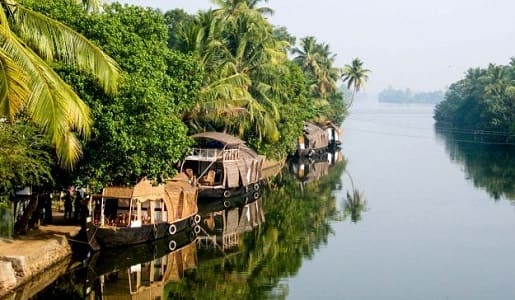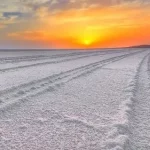India is blessed with the rich source of minerals, green lushes, a valley of flowers, beautiful rivers etc. Besides, it is enriched with plenty of beautiful lakes from Kashmir to Kanyakumari.
It is a country as diverse in history, culture, and topography, which is why it attracts many tourists around the globe. Indian lakes can be categorized into two types: Natural lake and an artificial lake. The Natural Lake can be further classified into Brackish Water Lake, Freshwater lakes. Brackish water is partially saline and is separated from the sea though thin reefs. The reservoir created for the dam is considered as the artificial lake. Freshwater lakes are more than the artificial lakes. Sasthamkotta lake and Dal lake are some of the best examples of freshwater lakes. Hussain lake and Chill lake are both artificial reservoir.
The Indira Sagar Lake is the biggest reservoir in India. The Lonar Crater is the largest Crater in India. There are so many beautiful freshwater lakes out there, which are popular for fishing, bird watching, and other water activities. The list includes Nal Sarovar lake, pulicate Lake, Kolleru Lake etc. The largest freshwater lake is wular lake which covers 260 square km. The largest Brackish water lake is Chilka lake. Pangong Tso in Jammu & Kashmir is the biggest saltwater lake in India. The longest Lake in India is Tso-Lamho, which is 14th highest lake in the world. Gobind Sagar lake is the deepest lake in India and the longest Indian Lake is Vembanad lake. In this article, we gonna see the list of top 10 biggest Indian lakes based on the surface area of lakes.
List of Biggest Lake in India
10. Wular Lake
The maximum surface area of the lake is 259 square kilometer, which makes it the 10th biggest Indian lake in this list. It is one of the largest freshwater lakes in Asia. Geographically located in the state of Jammu & Kashmir, the Wular Lake is the major part of the Jhelum River Basin. The size of the lake varies from 12 to 100 square kilometers. Due to the Willow plantation, much of the Wular Lake has drained.
It serves as the main source for fishing and agriculture. The Wular Lake is famous for the migrated birds, which fly more than a mile from other districts to Wular. It provides essential habitats for fish, birds and endangered species like Fishing cat, White Bellied sea eagle etc. The lake is an important fish habitat, which houses a rich variety of rare species such as rosy barb, common carp, Sattar snow trout, Chirruh Snowtrout and much more. The most beautiful tourist destination can be seen from Saderkota Park.
9. Nagarjuna Sagar Lake
With the surface area of 285 square kilometers, NagarJuna Sagar Lake ranks as 9th among the list of top 10 biggest lakes in India. It is the world’s third-largest Man-made Lake. The Nagar Juna Lake was founded in1966 when the tallest mansory dam was built across the Krishna River. The Nagar Juna Sagar Lake was founded in the name of Buddhist Monk Nagarjuna who ruled India during the second century.
8. Lotkak lake
With the maximum depth of 4.6m, Lotkak is the fifth longest river in India. Lotkak River is located in Manipur. The best part about the Lotkak River is it is the only floating lake in India. The lake is enriched with loads of floating phumids. Keibul Lamjao National park is the floating park, which is located around the Lotkak Lake. The lake is the primary source of irrigation, drinking water supply, and hydropower generation.
The catchment area is about 980 square kilometer. The average depth is 2.7 m. The lagoon is the source of livelihood of many fishermen who live across the river. The lake has a rich variety of flora and fauna. Till date, 14 species of birds and 57 species of water birds are found in the lake. The list includes barking deer, sambhar, Indian python etc. To conserve these rare species, keibul Lamjao National park was established.
7. Sardar Sarovar lake
With the surface area of 375 square kilometers, Sardhar Sarovar Lake stands at 7th place on the list of top 10 biggest lakes in India. It is the fresh water reservoir with the total capacity of 9.5 cube kilometer. The active capacity of the reservoir is 5.8 cube kilometer. Sardar Sarovar dam is one of the largest dams in the World. The dam provides flood protection to 210 villages surrounding the lake. The sardhar Sarovar serves as a prime source of water for solar power generation.
6. Pulicate Lagoon
Pulicate is the second biggest water Lagoon in India. The maximum area of pulicate Lagoon is 759 square kilometer, which makes it the 2nd largest brackish water body in India. It is also one of the important wetlands to attract the Monsoon clouds to Tamilnadu. The pulicate Lagoon spread between Tamilnadu and Andrapradesh and comprises three different regions include Venadu Reserve Forest, pernadu Reserve Forest, and Marshy Land region. There is Sriharikota Link Road, which divides the lank into marshy land and freshwater land.
The Pulicate Lake Bird Sanctuary is situated near the Pulicate lake which attracts many tourists. The maximum width of the lake is 17.5km and the maximum length is 60 km. The average depth of this lagoon is 1m. The boundary of Pulicate lagoon ranges between 13.33 degree to 13.66 degrees to North and 80.23 degrees to 80.25 degrees to the East. The lagoon is enriched with a wide variety of flora and fauna, which supports the fisheries. The lagoon is bestowed with rich fish variety and new backwater species such as catfish and Mullets.
5. Indira Sagar lake
Indira Sagar lake is the most beautiful Indian lake which is an artificial reservoir created by Indira Sagar Dam. It covers an area of 583 square kilometers, which makes it the biggest lake in India. Indira Sagar lake is situated at Mundi at Madhya Pradesh. It is also considered as the longest river in terms of volume.
4. Pangong Tsoa
Pangong Tsoa is a type of saline lake which is located in the Laddak region of Jammu& Kashmir. The lake covers an area of 700 square kilometers and has the maximum depth of 100 m. Pangong Tsao is shared between China and India. During the winter season, the lake freezes completely despite the saline water. The Status Quo of this lake has been maintained since china war 1962.
3. Shivsagar Lake
The surface area of Shivsagar Lake is 891 square kilometer, which makes it the 3rd biggest lake in India. The shivsagar lake was located in Satara, Maharastra. The maximum depth is 80 m and the maximum length is 50 km. It is the must-visit place in Maharashtra. The koyna dam was located at the end of Shivaji Sagar Lake. Unlike other dams, The water released from koyna dam flows to the Bay of Bengal and is stored in many dams on the way. Thus, it serves as the prime source of water for many villages surrounding the lake.
2. Chilka Lake
With the maximum depth of 4.2m, Chilka Lake is considered as the 2nd biggest lake in the list. It is also the biggest lake since it covers an area of 1165 square kilometer. Chilka Lake is one of the most beautiful Indian lakes that adds charm to Odisha. Being a Coastal lagoon, Chilka Lake is separated from the Bay of Bengal by a thin strip of land. The lake is situated on the east coast of Odisha. Moreover, the lake is a kind of brackish lagoon, which is popular for the flora and fauna around the lake. There is a different kind of birds in Odisha that migrated from Mongali and Russia to reach the Chilka Lake.
1. Vembanad Lake

Geographically located on the west coast of Kerala and covers an area of 2033 square km, making it India’s highest lake. Vembanad Lake is also known as Kochi lake and Punnamada lake. The lake is surrounded by Emakulam, and Alappuzha. Vembanad lake is a popular tourist attraction across Kochi. With the maximum height of 96.5 km, it is considered as the longest lake in India. Kerala backwater house is of the essential aspects of Kerala tourism. Vembanad lake is divided into two parts; one is fresh water while other is half-brackish, which is separated from the Arabian sea by saline water. To prevent the saltwater barrier, thannermukkom was built in 1974.
This was the list of top 10 biggest Lakes in India. Beautiful lakes, fresh rivers, Bulletproof dams are abundant in India. It is the sole responsibility of Indians to preserve lakes and take care of the organism living in it. There are many ways to keep lakes clean and safe. However, there are certain things that we should avoid to keep the fresh water clean, such are dumping wastes into water, leaving electronic items, and other harmful batteries, using commercial fertilizers etc. learn as much as you can about the risks that lakes face and try to save the environment.
Santosh Kumar, the author behind IndiasStuffs.com, is passionate about sharing valuable insights on a variety of topics, including lifestyle, technology, and Indian culture.
Page Contents

